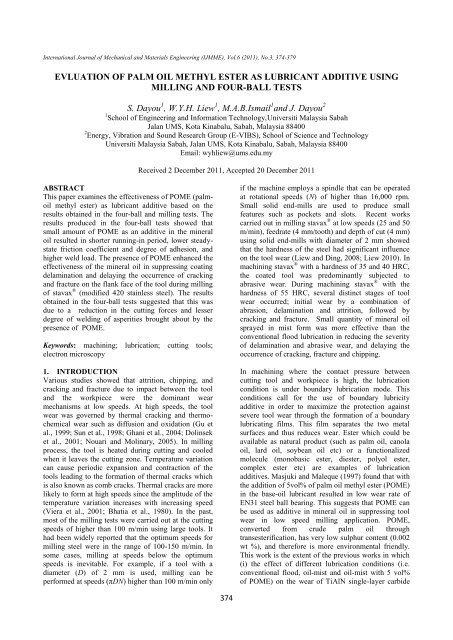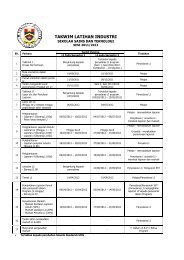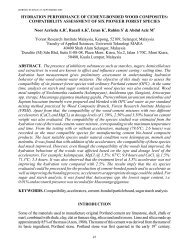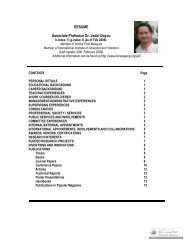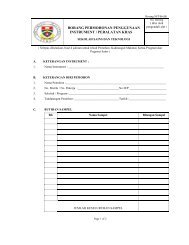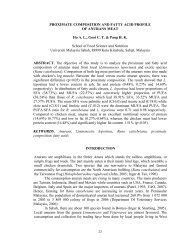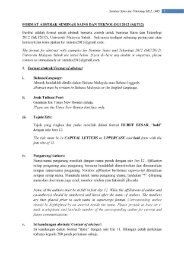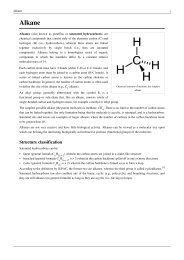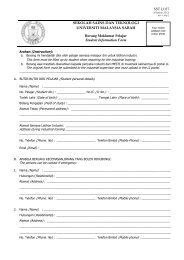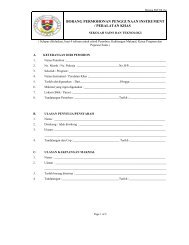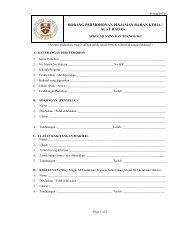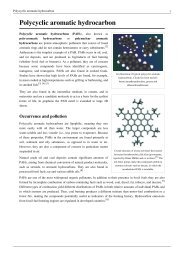Download File - Universiti Malaysia Sabah
Download File - Universiti Malaysia Sabah
Download File - Universiti Malaysia Sabah
You also want an ePaper? Increase the reach of your titles
YUMPU automatically turns print PDFs into web optimized ePapers that Google loves.
Coefficient of frictionwear. Therefore, the smooth surface and low frictioncoefficient produced in emulsified water based-coolantwas not solely due to the inhibition of adhesive wearby the formation of interfacial films.Figure 4 Examination of the steel balls tested at 800 Nin mineral oil without POME at higher magnificationshows that the worn surface has numerous cavities,indicating of adhesive wear.The smallest wear scar diameter was obtained inemulsified water-based coolant (Table 1) due to thecombination of the shortest running in period andlowest prevailing steady-state wear. Running-inprocess is the stage where large amount of material lossoccurs (So and Lin, 1999). Under oil lubrication, thepresence of POME resulted in smaller worn scars andhigher values of weld load in comparison to the oilwithout POME. Under such high loads when thepossibility of seizure is high, oil lubricant reduces thecontact between the two contacting surfaces throughthe formation of a lubrication film. The film formationis typically caused by the adsorption of the additive onthe contacting metal interface through chemicalreactions. The high chemical affinity at the contactsurface region is caused by the synergistic effect of avery high surface energy and active sites from thefreshly abraded surfaces (nascent) and flashtemperature generated from the collision of asperitiesfrom one surface to the other sliding surface (Hsu andGates, 2005). The protective role of the film is furtherimproved with the presence of POME. Thecharacteristics of the friction coefficient at a lower loadof 300 N appeared to be different from those obtainedat the higher loads. At 300 N, no drop in thecoefficient of friction was observed in the running-inprocess and the steady-state friction coefficientobtained in oil without POME, oil with 5% POME andemulsified water-based coolant was essentially thesame (Figure 5). Under this condition, hydrodynamiclubrication prevails whereby a hydrodynamic liftgenerated by the liquid pressure of the lubricant is greatenough to keep the contacting surfaces to be separated.Under this lubrication condition, the only frictioninvolved in the system was the viscous shear of thelubricant (Avitzur, 1990). The coefficient of friction377produced in plain mineral oil and mineral oil withPOME additive was essentially the same due to theirsimilar viscosity characteristics.Table 1 Weld load and wear scar diameter for differentlubrication conditionsLubricationconditionEmulsifiedwater-basedcoolantMineral Oil(withoutPOME)Mineral Oilwith 5vol%POME0.120.10.080.060.040.020Weldload(N)Average diameter scar (mm)produced at the nominal loadsof300N 600N 700N 800N1050 0.30 0.59 0.65 0.731200 0.28 1.97 2.30 2.601400 0.29 1.79 2.20 2.300 10 20 30 40 50 60 70Time (second)0% POME5% POMEWater-based CoolantFigure 5 The change in friction coefficient in differentlubrication conditions at nominal load of 300N.3.2 Effect of lubrication on the tool wearprogressionFigure 6 shows the change in the maximum flank-wearwidth V B with cutting distance in milling stavax ® underflood and oil mist (with and without POME)lubrications. Three distinct stages of tool wearoccurred. In this initial stage of machining,delamination, attrition and abrasion were the dominantwear mechanisms. Removal of coating by thecombination of these wear mechanisms exposed thesubstrate. Cracks were then formed on the carbidesubstrate exposed on the flank face. This was followedby the formation of individual surface fracture at thecracks which would then enlarge and coalesce to forma large fracture surface. These cracks propagated in a
direction parallel to the cutting edge are often referredas mechanical or fatigue cracks. SEM images of theworn surfaces showing evidences of delaminationwear, cracking and fracture can be seen in the workspublished by Liew and Ding (2008) and Liew (2010).Oil-mist lubrication was more effective in delaying theoccurrence of cracking and fracture. The effectivenessof water-based and oil-based lubricants in reducing thefrictional forces and wear depends on the frictionalcondition. In high-speed machining, the hightemperature generated is the primary concern becauseit causes excessive adhesive wear and softening of thematerial leading to high wear. Under suchcircumstances, water-based lubricants are likely toperform better as they are better coolants than oil-basedlubricants. However, in low-speed machining wherethe heat gave beneficial effects (i.e. reducing thehardness of the work material, and hence the cuttingforce and the severity of abrasion) and mechanicalwear (such as abrasion, delamination, cracking andfracture) occurred, the use of lubricant with higherviscosity and lower cooling ability such as oil-basedlubricant resulted in lower wear rate.It was found that the presence of POME in the oil-mistlubricant further delayed the occurrence of crackingand fracture. This could be a direct result of areduction in the cutting forces and the degree ofwelding of asperities brought about by the POME (asdemonstrated in the four-ball tests) which in turnreduced (i) the severity of the impact of the tool on thework material and (ii) the removal rate of the coatingin the initial stage of machining, giving the toolsubstrate greater suppression of fatigue crack initiation(Toudt et al., 2000; Lackner et al., 2006; Hogmark etal., 2000; Liew, 2010).4. CONCLUSIONThe results obtained in the four-ball tests showed thatsmall amount of POME as an additive in the mineraloil resulted in shorter running-in period, lower steadystatefriction coefficient and degree of adhesion, andhigher weld load. Compare to the flood lubrication,small quantity of mineral oil sprayed in mist form wasmore effective in reducing the coating delaminationand delaying the occurrence of cracking and fracture.The presence of POME in the oil-mist lubricant furtherdelayed the occurrence of cracking and fracture. Thiscould be due to a reduction in the cutting forces andlesser degree of welding of asperities brought about bythe POME POME (as demonstrated in the four-balltests) which in turn reduced (i) the severity of theimpact of the tool on the work material and (ii) theremoval rate of the coating in the initial stage ofmachining, giving the tool substrate greatersuppression of fatigue crack initiation.ACKNOWLEDGEMENTThe authors wish to thank Ministry of HigherEducation, <strong>Malaysia</strong> for funding this project(Fundamental grants number FRG0210-TK1/2010 andFRG0215-TK1/2010) and Mr. John Paulus for carryingout the machining tests.Figure 6 The change in dominant wear mechanism andthe flank wear under flood and oil-mist (with andwithout POME) lubrications. The alphabets indicatethe operating wear mechanism on the flank face.a:abrasion and attrition, c:cracking, f:fracture. Coatingdelamination took place in all cutting conditions.REFERENCEAvitzur, B. 1990. Boundary and hydrodynamiclubrication. Wear 139: 49-76.Baets, P. de, Kalacska, G., Strijckmans, K., De Velde,F. Van, Van, A.P. and Peteghem. 1998.Experimental study by means of thins layeractivation of humidity influence on the frettingwear of steel surface. Wear 216:131-137.Bhatia, S.M., Pandey, P.C. and Shan, H.S. 1980. Thethermal condition of the tool cutting edge inintermittent cutting. Wear 61:21-30.Chalakov, C.S. and Rowe, G.W. 1992. Lubricatingproperties of grinding fluids II. Comparison offluids in four-ball tribometer tests. Wear 155:331-342.Dolinsek, S., Sustarsic, B. and Kopac, J. 2001. Wearmechanisms of cutting tool in high-speed milling.Wear 350:349-356.Ghani, J.A., Choudhury, I.A. and Masjuki, H.H. 2004.Wear mechanism of TiN coated carbide anduncoated cermets tools at high cutting speed378
applications. Journal of Materials ProcessingTechnology 153-154:1067-1073.Goto, H. and Amamoto, Y. 2003. Effect of varyingload on wear resistance of carbon steel underunlubricated conditions. Wear 254:1256-1266.Gu,, J., Barber, G., Tung, S. and Gu, R-J. 1999. Toollife and wear mechanism of uncoated and coatedmilling tools. Wear 225: 273-284.Hogmark, S., Jacobson, S. and Larsson, M. 2000.Design and evaluation of tribological coatings.Wear 246:20-33.Hsu, S.M. and Gates, R.S. 2005. Boundary lubricatingfilms: formation and lubrication mechanism.Tribology International 38:305-312.Lackner, J.M., Waldhauser, W., Major, L., Morgiel, J.,Kot, M. and Major, B. 2006. NanocrystallineCr/CrN and Ti/TiN multilayer coatings produced bypulsed laser deposition at room temperature.Bulletin of the Polish Academy of Sciences 54:175-180.Liew, W.Y.H and Ding, X. 2008. Wear progression ofcarbide tool in low-speed end milling of stainlesssteel. Wear, 265:155-166.Liew, W.Y.H. 2010. Low-speed milling of stainlesssteel with TiAlN single-layer and TiAlN/AlCrNnano-multilayer coated carbide tools under differentlubrication conditions. Wear, 269:617-631.Masjuki, H.H. and Maleque, M.A. 1997. Investigationof the anti-wear characteristics of palm oil methylester using a four-ball tribometer test. Wear206:179-186.Nouari, M. and Molinari, A. 2005. Experimentalverification of a diffusion tool wear model using a42CrMo4 steel with an uncoated cemented tungstencarbide at various cutting speeds. Wear 259:1151-1159.So, H. and Lin, R.C. 1999. The combined effects ofZDDP, surface texture and hardness on the runninginon ferrous metals. Tribology International32:143-153.Stoudt, M.R., Cammarata, R.C. and Ricker, R.E. 2000.Suppression of fatigue cracking with nanometerscalemultilayered coatings. Scripta Materialia43:491-496.Sun, F., Li, Z., Jiang, D. and Chen, B. 1998. Adheringwear mechanism of cemented carbide cutter in theintervallic cutting of stainless steel. Wear 214:79-82.Tyfour, W.R., Beynon, J.H. and Kapoor, A. 1995. Thesteady state wear behavior of pearlitic rail steelunder dry rolling-sliding contact conditions. Wear180:79-89.Viera, J.M., Machado, A.R. and Ezugwu, E.O. 2001.Performance of cutting fluids during face milling ofsteels. Journal of Materials Processing Technology116:244-251.Wang, Y. and Lei, T.Q. 1996. Wear behavior of steel1080 with different microstructure during drysliding. Wear 194:44-53.Welsh, N.C. 1963. The dry wear of steels: II.Interpretation and special features. Philos. Trans. R.Soc., Ser. A 257:31-50.379


